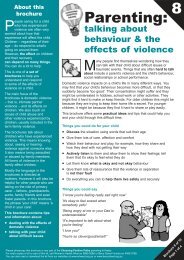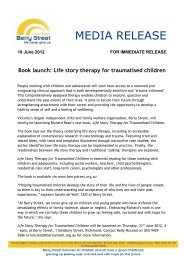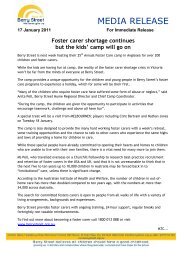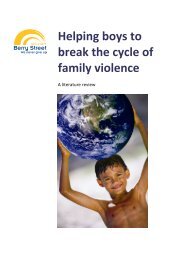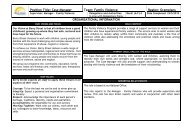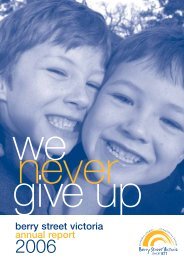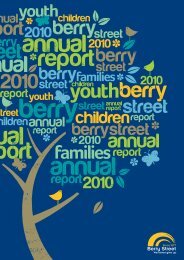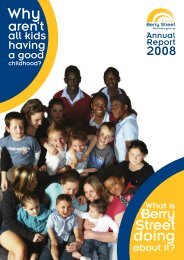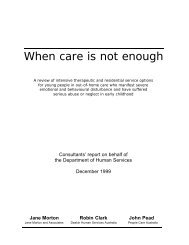Therapeutic foster care - Berry Street Childhood Institute
Therapeutic foster care - Berry Street Childhood Institute
Therapeutic foster care - Berry Street Childhood Institute
You also want an ePaper? Increase the reach of your titles
YUMPU automatically turns print PDFs into web optimized ePapers that Google loves.
These matching processes have been shown to<br />
enhance placement stability.<br />
12. In TFC the <strong>care</strong>r is considered to be therapeutic in<br />
their parenting practices, so that therapy is much<br />
more than the domain of the mental health<br />
clinician.<br />
13. Specialist frameworks and skills are needed in the<br />
assessment processes of <strong>care</strong>givers in TFC. There<br />
is a need for practice standards in these<br />
assessment processes, not to raise the bar but to<br />
increase the knowledge of workers whose aim is<br />
to understand and support <strong>care</strong>rs.<br />
14. Common to all TFC programs is the emphasis<br />
placed on enhanced training and support for<br />
<strong>care</strong>rs, to provide good outcomes.<br />
15. There are a number of factors which increase the<br />
chances of successful training.<br />
16. Established TFC programs in the U.S. and U.K.<br />
generally promote contact between <strong>care</strong>rs and<br />
biological family, and have therapeutic services<br />
aimed to assist biological family, as this family<br />
involvement has proven to be a critical element in<br />
provided good outcomes for children. Research<br />
has shown that a <strong>care</strong>r's anxiety about a child's<br />
contact with biological family is associated with<br />
poor child adjustment.<br />
17. Ideas for a practice model of TFC in a Victorian<br />
context might include:<br />
• A comprehensive assessment framework<br />
• A trauma-attachment model within a systemic<br />
framework<br />
• <strong>Therapeutic</strong> parenting<br />
• Strong <strong>care</strong> team/collaborative approach,<br />
providing a 'reflective space'<br />
• Attachment focused dyadic or family therapy<br />
• Therapy and case management for the<br />
biological family<br />
• Focus on permanency, either with biological or<br />
<strong>foster</strong> family<br />
• Supervision, consultation and support for<br />
<strong>care</strong>rs and workers, with a focus on self <strong>care</strong><br />
• Creative support and respite options, such as<br />
the 'Mirror Families' initiative<br />
A trauma-attachment<br />
framework<br />
Children with trauma-attachment difficulties present<br />
a significant challenge for all who work with them, in<br />
understanding and responding to their needs. An<br />
integration of trauma and attachment theories offers<br />
a useful framework in understanding children's<br />
difficulties, making sense of their thoughts, emotions<br />
and behaviours and guiding interventions for them.<br />
In examining therapeutic <strong>care</strong> models, an emphasis<br />
on the importance of developing secure attachments<br />
through therapeutic parenting as well as treatment<br />
which may facilitate this development deserves<br />
considerable attention. “In attachment-focused therapies<br />
the aim is to help children use their <strong>care</strong>r as a secure base<br />
from which they can explore the unhappy and painful<br />
aspects of their past and of their present” (Golding 2006,<br />
p. 343). For this reason, this literature review adopts a<br />
preference for therapeutic models that utilised a<br />
trauma-attachment approach which emphasised a<br />
relational approach to treatment interventions.<br />
Throughout this document there is reference to a<br />
'trauma and attachment framework'. It is most useful<br />
to integrate the theories developed around both<br />
trauma and attachment when trying to understand<br />
the complex worlds of children who have suffered<br />
abuse and neglect: attachment theory because it<br />
speaks of human relationship development from prebirth<br />
throughout the human life span and trauma<br />
theory because it helps us to understand the<br />
neurobiological and social impact of abuse and<br />
neglect on the human individual (See Appendix 2.)<br />
Mental health problems of<br />
children in <strong>care</strong><br />
The interplay of trauma and attachment<br />
Children in <strong>care</strong> are particularly vulnerable to<br />
developing social, emotional and psychological<br />
difficulties. In entering the <strong>care</strong> system, children have<br />
often already experienced a multitude of difficulties,<br />
such as abuse and neglect, family histories of mental<br />
illness or drug and alcohol abuse, exposure to<br />
substance abuse and family violence, family<br />
dysfunction and criminality (Schneiderman et al.,<br />
1998). These experiences are often compounded by<br />
the separation that is inextricably created when a<br />
child enters <strong>care</strong> and the associated loss of family,<br />
culture, community, peers and, frequently, school<br />
environments. Such experiences of loss, trauma and<br />
disruption have a significant impact on children<br />
developing secure attachment relationships as well as<br />
their capacity to later form attachments with a new<br />
<strong>care</strong>r (Golding, 2006). A secure attachment is<br />
fundamental to a child's development and is<br />
regarded as a key protective factor while an insecure<br />
attachment is a risk factor and is often associated with<br />
children who have experienced abuse and neglect<br />
(Golding, 2006).<br />
Attachment and culture<br />
In light of the over-representation of Aboriginal<br />
children in out of home <strong>care</strong> and the growing<br />
application of trauma-attachment based models of<br />
interventions with children in <strong>care</strong>, it is important to<br />
understand the interplay between attachment and<br />
culture. Attachment theory has largely evolved from<br />
6 <strong>Therapeutic</strong> Foster Care





